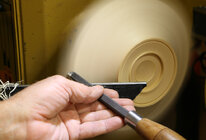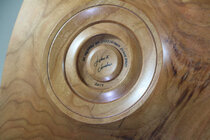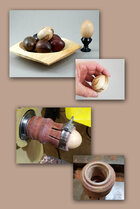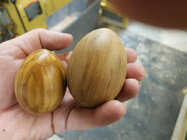This image below comes from a post from @John K Jordan in another thread. However, it reminded me I keep meaning to ask this question about parting, and cleaning up the nub or remaining unwanted wood on the parted workpiece.
I've been turning, on and off, since 2020. I have a decent amount of skill, but I'm in that phase, and have been for a bit here, where I'm never really satisfied with my work. I've gone through rounds with sanding techniques, tooling techniques, grinding techniques. I have good skill, but, also never quite satisfied and always trying to improve. Currently, I think my single greatest struggle, is getting good, clean results on my workpieces, after parting. I have a lot of trouble with this.
FWIW, this is mostly on smaller items, like those pictured in John's photo above. This really is not an issue with bowls or platters, its spindle type pieces mostly, although I sometimes have issues parting vases as well (mostly, tearout on the bottom...which seems to occur as a result of the parting process with parting tools, even when they are as sharp as I can make them.
When I first started, I used parting tools, left a bit of wood on, sanded that down. But it never looked good. So I started parting part way, then sawing through the connecting piece of wood, which also left a piece of wood, but I was able to make it smaller. I still couldn't get really great results, and there were often shape issues, and with certain woods sanding that wood down can take ages. I tried "carving" that wood off for a while, and that seemed to lead to worse shape issues. I then tried to actually turn the piece right off, shaping optimally as I went, and 90% of the time the piece would break off, shredding fibers right into the piece, which then of course was unfixable. So I went back to parting tools and sawing the last little bit to leave a little nub of wood, and I'm still trying to figure out the best way to deal with that.
Recently, after parting and sawing off the workpiece, I have taken to using a rasp, to remove the nub, and try and lightly shape. I then sand, and its hit or miss, whether I can actually get a nice, clean, quality surface around the parting point that looks seamless with the rest of the piece. However, using the rasp, has improved things, it gives me more control than trying to sand off the remaining wood nub with a sanding disc, and I'm able to keep a better shape overall most of the time. The thing that is really challenging for me, is getting the final finish around the parted area to look as nice as the rest of the workpiece.
A secondary issue I have with parting, and this mostly happens with vases where I may be parting through a larger area of wood (the base of my vases are usually around 2" in diameter across most of the time, or larger), is tearout in the fibers on the bottom of the piece. Even when I sharpen the parting tool as much as I possibly can, it still seems like most woods that I turn, end up tearing out. I've tried varying my speed, going very slowly...which does minimize the issue, but it does not seem to eliminate it. I don't know if I've turned a vase yet where I really like the base...they all seem to look terrible.
So anyway. Curious how everyone else parts their workpieces. What the tricks are to produce a clean, high quality result in the parted areas, and avoid serious problems like tearout (which can essentially be unfixable, since it can extend so far into the wood.)
I've been turning, on and off, since 2020. I have a decent amount of skill, but I'm in that phase, and have been for a bit here, where I'm never really satisfied with my work. I've gone through rounds with sanding techniques, tooling techniques, grinding techniques. I have good skill, but, also never quite satisfied and always trying to improve. Currently, I think my single greatest struggle, is getting good, clean results on my workpieces, after parting. I have a lot of trouble with this.
FWIW, this is mostly on smaller items, like those pictured in John's photo above. This really is not an issue with bowls or platters, its spindle type pieces mostly, although I sometimes have issues parting vases as well (mostly, tearout on the bottom...which seems to occur as a result of the parting process with parting tools, even when they are as sharp as I can make them.
When I first started, I used parting tools, left a bit of wood on, sanded that down. But it never looked good. So I started parting part way, then sawing through the connecting piece of wood, which also left a piece of wood, but I was able to make it smaller. I still couldn't get really great results, and there were often shape issues, and with certain woods sanding that wood down can take ages. I tried "carving" that wood off for a while, and that seemed to lead to worse shape issues. I then tried to actually turn the piece right off, shaping optimally as I went, and 90% of the time the piece would break off, shredding fibers right into the piece, which then of course was unfixable. So I went back to parting tools and sawing the last little bit to leave a little nub of wood, and I'm still trying to figure out the best way to deal with that.
Recently, after parting and sawing off the workpiece, I have taken to using a rasp, to remove the nub, and try and lightly shape. I then sand, and its hit or miss, whether I can actually get a nice, clean, quality surface around the parting point that looks seamless with the rest of the piece. However, using the rasp, has improved things, it gives me more control than trying to sand off the remaining wood nub with a sanding disc, and I'm able to keep a better shape overall most of the time. The thing that is really challenging for me, is getting the final finish around the parted area to look as nice as the rest of the workpiece.
A secondary issue I have with parting, and this mostly happens with vases where I may be parting through a larger area of wood (the base of my vases are usually around 2" in diameter across most of the time, or larger), is tearout in the fibers on the bottom of the piece. Even when I sharpen the parting tool as much as I possibly can, it still seems like most woods that I turn, end up tearing out. I've tried varying my speed, going very slowly...which does minimize the issue, but it does not seem to eliminate it. I don't know if I've turned a vase yet where I really like the base...they all seem to look terrible.
So anyway. Curious how everyone else parts their workpieces. What the tricks are to produce a clean, high quality result in the parted areas, and avoid serious problems like tearout (which can essentially be unfixable, since it can extend so far into the wood.)






